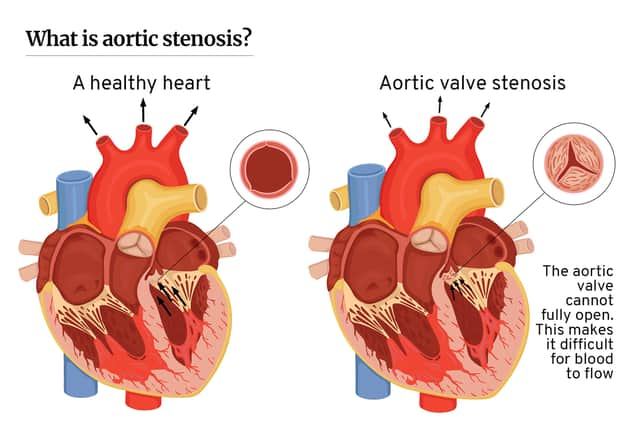What is aortic stenosis? Signs, symptoms of heart valve narrowing, what causes disease and murmur - NHS advice
and live on Freeview channel 276
Almost 300,000 people in the UK could have a potentially deadly heart valve disease, with close to 100,000 not showing any symptoms of the condition.
But what is aortic stenosis, what are the symptoms and what did the study find?
Here’s what you need to know.
What is aortic stenosis?
Advertisement
Hide AdAdvertisement
Hide AdAortic stenosis is a narrowing of the aortic valve opening, restricting the blood flow from the left ventricle to the aorta. It may also affect the pressure in the left atrium.
According to the NHS, the two main aortic valve diseases are:
- aortic stenosis – where the valve is narrowed, restricting blood flow
- aortic regurgitation – where the valve allows blood to leak back into the heart
These problems can be something you’re born with or can develop later in life.
Some of the main causes of aortic valve disease include:
- senile aortic calcification – where calcium deposits form on the valve as you get older, preventing it opening and closing properly
- bicuspid aortic valve – a problem present from birth in which the aortic valve only has two flaps instead of the usual three, which can cause problems as you get older
- underlying conditions that can damage the aortic valve – including Marfan syndrome, Ehlers-Danlos syndrome, rheumatic fever, lupus, giant cell arteritis and endocarditis
What are heart murmurs?
Abnormal heart murmurs in adults are usually related to defective heart valves.
Abnormal heart murmurs in adults may be related to:
- Valve calcification
- Endocarditis
- Rheumatic fever (PDF)
What did the study find?
Advertisement
Hide AdAdvertisement
Hide AdThe new study found that the likely extent of aortic stenosis within the UK exceeds the NHS’s capacity to treat.
An international study, with experts from the universities of Glasgow and Southampton, was started to establish the extent of the disease in the UK.
The report was published in the journal Open Heart and estimated that in 2019, 291,448 men and women aged 55 and over had severe aortic stenosis.
Of this, 68% had symptoms, which meant 92,389 did not show signs of the potentially fatal condition.
Advertisement
Hide AdAdvertisement
Hide AdThe authors predicted that 59% of people with aortic stenosis will "die within five years without proactive management".
They also said the disease is a "common condition" in the UK, warning that "without appropriate detection and intervention, survival prospects are likely to be poor".
Although roughly 20,000 new patients would benefit from treatment each year, the researchers said this is "discordant with current capacity within the NHS".
Researchers wrote: "These data suggest a high burden of severe aortic stenosis in the UK requiring surgical or transcatheter intervention that challenges the ongoing capacity of the National Health Service to meet the needs of those affected.”


What are the symptoms?
Symptoms may include:
- chest pain brought on by physical activity (angina) – caused by your heart having to work harder
- shortness of breath – this may only be noticed at first when you exercise, but later you may experience this even when resting
- dizziness or lightheadedness – caused by the obstruction of blood flow from your heart
- loss of consciousness (fainting) – also a result of reduced blood flow
Advertisement
Hide AdAdvertisement
Hide AdIn particularly serious cases, aortic valve disease can lead to life-threatening problems such as heart failure.
What is the treatment?
The NHS said that if you have an aortic valve disease and you have no or only mild symptoms, you will probably be monitored to check whether the condition is getting worse.
However, if your symptoms become more severe, you will probably need surgery to replace the valve.
“Without treatment, severe aortic valve disease is likely to get worse and may eventually be fatal,” said the NHS website.
Comment Guidelines
National World encourages reader discussion on our stories. User feedback, insights and back-and-forth exchanges add a rich layer of context to reporting. Please review our Community Guidelines before commenting.
